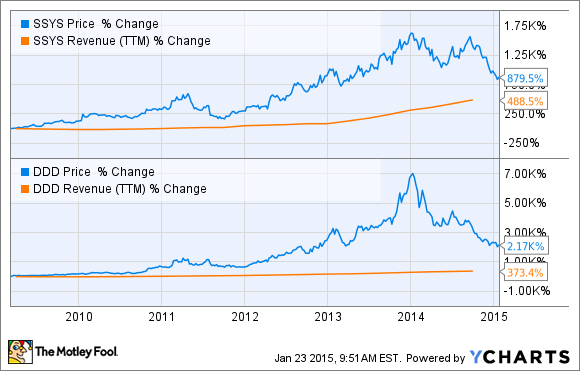At one time or another, Stratasys (SSYS -2.85%), 3D Systems (DDD -5.52%), Twitter (TWTR), and GoPro (GPRO -0.93%) were all darlings of Wall Street. Some investors may still view these high-growth stocks in a bullish light. However, we asked three Foolish contributors to explain why they believe the road ahead will be a bumpy one for these once high-flying growth companies.
Alex Planes (Stratasys and 3D Systems): My colleagues have both made choices I agree with, but luckily, there's no shortage of overhyped high-growth market darlings. Two of those, 3D printing twin titans Stratasys and 3D Systems, have absolutely trounced the market's performance since the rebound began in 2009:
These two 3D printing companies followed the classic pattern of bubble stocks during the post-crisis era so closely that the only people who should be surprised by 2014's 3D printed collapse are those who have never seen a bubble stock before.
The bubbles had realistic underpinnings (3D printing is an important new technology) that led to a marketwide mass delusion (3D printing will change the world tomorrow!) that broke once it became clear that neither Stratasys nor 3D Systems were actually building stronger financial positions as they consolidated the industry. To date, despite a year of backsliding, neither stock's growth since the start of the rebound is remotely in line with revenues:
Internet stocks suffered a similar fate 15 years ago, and the lesson there is valuable. Plenty of dot-com stocks are gone forever, and few of those that are still around have ever recaptured their former heights. Why? For one thing, most of them wound up eclipsed by better companies with stronger technology.
Stratasys and 3D Systems have attempted to avoid the dot-com curse by simply buying up competitors, but companies with a legitimate technological edge are not biting the buyout hook too eagerly. A number of core 3D printing patents have already expired or are due to expire soon, and while 3D Systems and Stratasys bulls will tell you this doesn't really matter, it has massive implications for both companies because neither can hope to match interested mega-corporations like Hewlett-Packard or General Electric in R&D investment once it's time to develop the next generation of 3D printing technologies.
There's nothing wrong with being bullish on a technology, whether it's the Internet or 3D printing, while also recognizing that today' leaders in that technology could well end up in tomorrow's scrap heap.
Tim Brugger (Twitter): Fans of Twitter will no doubt point out that its stock price is up nearly 10% year to date, which is certainly worth getting excited about. But therein lies one of Twitter's problems for investors: Its stock price is all over the board, ranging from a low of $29.51 to a high over $67 a share in the last 52 weeks alone. The bigger problem is what's driving the tweet-master's wild stock ride.
Continued shake-ups of Twitter's senior management, CEO Dick Costolo reneging on his promise to not sell his holdings -- he shed 500,000 share just a few months after saying he wouldn't -- and continued concerns involving slowing user growth and engagement are not what investor's should expect from a company in a high-growth phase. But that's exactly where Twitter finds itself.
Adding insult to injury, there's also the not-so-small matter of Costolo and co-founder Evan Williams clearly not working from the same playbook. Williams, you may recall, went on record lamenting all the talk about monthly average users (MAUs) as a measuring stick just weeks after Costolo spent most of his presentation at Twitter's first-ever analyst day discussing how he was going to ramp-up MAUs and enhance engagement. Apparently, Williams must have missed Costolo's presentation.
As it stands, Twitter will continue to be volatile until it can demonstrate significant improvement in key areas such as MAU growth and engagement. A high-growth stock undergoing these particular problems this early in its life cycle? That's not the kind of excitement most investors want.
Jamal Carnette (GoPro): For me, the key word is "excited." And by that definition, my choice is GoPro. On one hand, the stock is among the most-shorted stocks on the Nasdaq, and on the other hand, it is one of the biggest "cult stocks" -- stocks people own because they love the product more so than the underlying investment. Considering the latter exists, it is entirely possible this company has a long runway for growth with its action cameras.
That said, I'm unsure of the total addressable market for a single-product-focused consumer-electronics company in the long term. In an ironic twist, the clever niche that propelled the company to the top of the action-camera market will eventually limit its continued growth without the introduction of new products. And even after the company's market capitalization dropped from more than $11 billion to $6.5 billion, the company still trades at valuations reserved for social media companies rather than consumer-electronics companies.
This is because the company has been playing up its social-media ambitions, but it hasn't produced any meaningful revenue from social media yet. And even when it starts to monetize its users' videos, there's no guarantee it will ever develop the meaningful scale that shareholders desire at these premium valuation levels. In the end, I could be totally wrong, and the young company could grow into its lofty valuations -- as it is clearly growing -- but I'll gladly watch this story from the sidelines.






